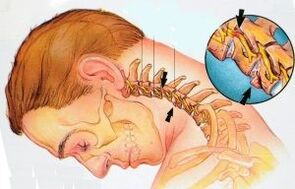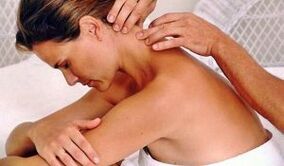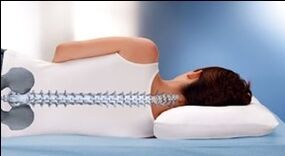
On the question: How to treat osteochondrosis of the cervical spine is an answer: to influence the cause of this disease itself if they are not an acute time.
Medicine deals with the examination - symptoms of the disease, not the cause.So do not hope for doctors, do not throw ointments, teas, injections, physiotherapy, simulators, massage in vain.None of the means listed helps them.
It is therefore categorical to say that my personal experience in the treatment of cervical osteochondrosis that I will be happy to share in the hope that it will help you to cope with this problem.
However, success in treatment depends on several diseases:
- Your desire to help yourself;
- Willingness to understand the true cause of cervical osteochondrosis;
- Compliance with the strictest self -discipline in treatment.
What you need to know about osteochondrosis of the cervical spine
To answer the question:How to treat osteochondrosis of the cervical spine,It is necessary to understand the cause of the disease well.To understand it, you have to contact the anatomy of the spine.
Our spine is a strong but flexible case for vital blood vessels and nerve trunks.Supporting the spine in good condition does not mean health problems.
But we, out of ignorance or due to a careless attitude to health at a young age, we treat the spine carelessly: excessively load it, take unpleasant poses, sit on the computer or at the table during the seat work, we spend a lot of time driving a car in a tense condition.

The cervical spine is the most mobile.It consists of seven vertebrae between which there are elastic intervertebral discs.They are clearly visible in the figure.The slices make the spine flexible and give strength at the same time.
Each intervertebral disc consists of a fibrous ring in which there is a pulpoose edge.
In the cervical spine, the cerebrospinal nerves and vertebral artery passes, which, due to the branched nerves and blood vessels, not only feeds the head together with the brain, but also the organs of the shoulder belt.
The cervical osteochondrosis are changes in the intervertebral discs of the cervical spine as a result of physical, inflammatory or mental exposure.The elasticity and strength of the intervertebral discs decrease while their height also decreases.
If you do not treat the disease, the fibrous ring of the intervertebral disc will be pressed and deformed in the future, which can lead to a lead.In more severe cases, the fibrous ring of the pane breaks, and the pulp core protrudes in the form of a hernia, while the nerve endings appear from the invertebral elements, as shown in the illustration.
The cause of the cervix osteochondrosis is therefore a change in the intervertebral discs in the cervical spine against the background of weak muscles.In addition, even slight muscle tension can lead to a shift in the vertebrae, with the nerve ends compressed and pain occurring.
However, there are many factors, which is why there is a change in the hard drives.This is a sitting lifestyle and an inherited predisposition, metabolic disorders and injuries as well as the storage of salts in the cervical spine and others.
How manifests the cervical osteochondrosis?All symptoms indicate that the inner vation and blood supply to the brain, neck and shoulder girdle are impaired due to changes in the intervertebral discs in innervation and blood supply.Therefore, symptoms of the neck osteochondrosis are headache in the back of the head and temple, Dizziness with a sharp turn of the head, noise in the ears, a decrease in visual acuity, the deterioration of the hearing deteriorated, the pain in the neck, shoulders, the shoulder blades, hands and sometimes in the heart.
Dizziness with a sharp turn of the head, noise in the ears, a decrease in visual acuity, the deterioration of the hearing deteriorated, the pain in the neck, shoulders, the shoulder blades, hands and sometimes in the heart.
If no cervical osteochondrosis is treated, diseases arise due to impaired brain distribution such as: migraines, high blood pressure, vegetovascular dystonia, hearing problems, eyes, coordination, with cardiovascular and respiratory systems.In advanced cases, brain element and a stroke can develop.
Personal experience in the treatment of cervical osteochondrosis
The diagnosis is cervical osteochondrosis, I received a neuropathologist at the age of 45.After examining the X-ray of my neck, he wrote on the map in addition to the diagnosis: the height of the panes between C5-C6 and C6-C7 vertebrae was significantly reduced.I was tortured by frequent headaches, in my ears, pain in the neck.
The question arose:How to treat osteochondrosis of the cervical spine.The doctor "calmed down" me calmly that osteochondrosis cannot heal completely because the intervertebral discs were deformed.He didn't prescribe me cheap at these prices, ointments and advised me to sit right at the table.It was the 90s, I bought the ointment according to the recipe for a neuropathologist in a left pharmacy.But the ointment of relief did not apply, the pain poisoned my life.
On the recommendation of acquaintances, I turned to the services of a paid specialist for manual therapy with higher medical training.After feeling my head after feeling the cervical vertebrae, it seemed to be 180 degrees, it was simple, enlightened and not painful.However, the procedure was clearly dangerous.The manoist warned that they have to sit directly at the table for three days and not in a favorite sauce.

I followed the recommendations for two days and then forgot.A few days later, my condition was the same as in front of a doctor - a manual.This experience told me how I can treat osteochondrosis of the cervical spine.After reading all the literature about osteochondrosis, I realized that I had to influence the cause of the disease independently.Doctors here are not assistants.It is impossible to change the deformation of the panes, but you can stretch the cervical spine and thereby reduce the pressure on the nerve ending and blood vessels.
In the house we always had a horizontal bar, in the morning, when they hang on it, they have a good route of the entire spine outside of their neck.I tried many ways to stretch my neck and developed my own system for the treatment of cervical osteochondrosis:
- Changed their attitude.It was not easy and did not happen immediately, but self -discipline and motivation helped me to feel healthy.I often looked into my posture in the mirror, checked it and went to the wall.My head should touch the wall of being in the same line with paragraphs.I always try to keep my head and shoulders straight.Today, when I'm 60, I have a better attitude than twenty years ago.
- I make the "Turtle" exercise from the Tao -Revitalization system every day and evening.Sometimes I do it more often when I feel tensions or hardening in the neck, upper back or in the upper shoulders.Make the turtle with sitting like in the figure:
- Sink your chin onto your chest and pull your head up with your head.Slowly inhale.At that time the neck stretches and the shoulders fall down;
- Slowly breathe out, take the back of the head down as if you want to touch you on your neck.The chin stretches, the neck stretches slightly.The shoulders rise on both sides of the head as if he wants to touch his ears;
- Repeat this cycle 10-12 times and try to do everything slowly.
The exercise of the turtle contributes to the safe stretching of the cervical spine, strengthens the muscles of the neck and shoulders, eliminates tiredness, hardening and pain, improves the metabolism and rejuvenates the body.
- In addition to the "turtle", I do an exercise to relax the entire shoulder girdle and also seat:
- Lift and lower their shoulders ten times;Tilt your head slowly to the left - 10 times to the right to every shoulder;
- Slowly tend your head forward - ten times back;
- Tend your head to the right (the right ear to the right shoulder), then slowly, stretch out your neck and throw your head, roll it on the spine and your left shoulder.Then from the left shoulder to the right.Make 10 cracks into each shoulder;
- Relax, straighten the spine again, balance the weight of the body on the coccyx and slowly start circular movements with an upper body from left to right, then ten times from right to left.At the same time, the head, the shoulders, the hands in the rotation are relaxed.
In addition to relaxation, this exercise brings the healing powers of the body and normalizes the energy nutrition of all cells and organs.
- When I work on the computer for a long time, I put on a neck collar (it can be bought in a pharmacy).I don't sit in there for long, an hour or two.In this way you can keep your head straight.
- When I noticed that I immediately (as read here) from an uncomfortable pose, for example on the television or in the country, in the country, in the country, in my ears or headaches, after that I do the exercise of the turtle.Call and fit pain within 5-10 minutes.

The relaxation and stretching of the muscles of the neck and shoulder girdle should become part of their daily life.Then you will feel great and have such a diagnosis as cervical osteochondrosis.
Consult your doctor before starting the exercises.
Here I would like to find that such treatment of the disease is possible outside the tightening.If you have an acute time with cervical osteochondrosis with nerve injuries before hypothermia or infection, see a doctor and take the prescribed blockade, injections, etc. As soon as the exacerbation passes, you can apply my method.
You are also a note: you can relax your neck muscles by taking hot shower on the neck or trapping in the bathroom.
Perform a mobile lifestyle, but avoid sharp cints of the head, heavy strain because the shoulder muscles are tense, the cramp of which changes the vertebrae and the roots of the nerves and blood vessels are violated on the neck.
Sleep too positive on a small pillow, often in the fresh air, so that your stress does not strain the cervical and shoulder zones and do not worsen the symptoms of osteochondrosis.

Stick to the right nutrition.Exclude baked goods from your diet.Eat more vegetables, fruit and grain.
Now I hope that you understand how to treat osteochondrosis of the cervical spine.
Trust yourself and live without pain with your cervical osteochondrosis!
























